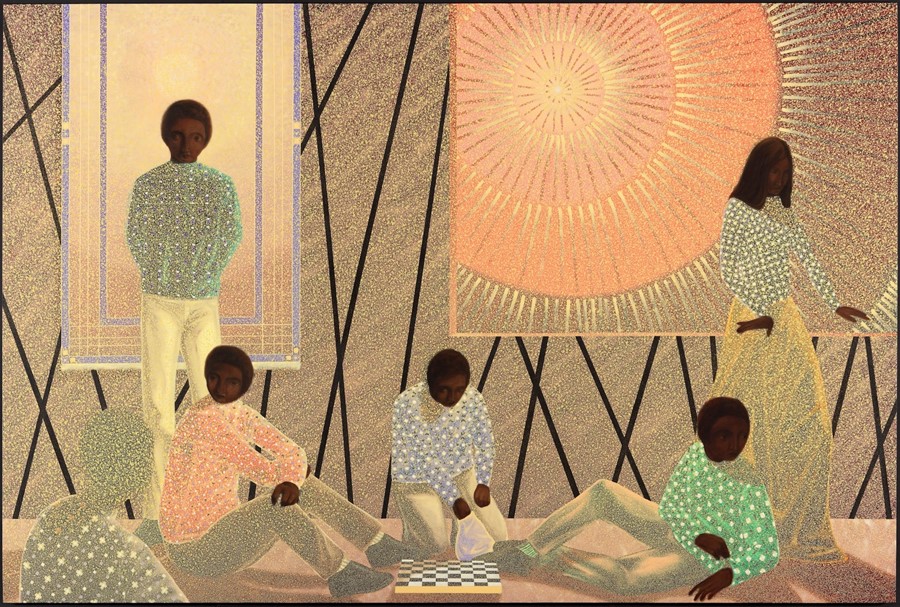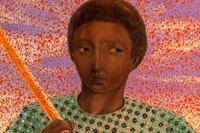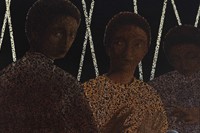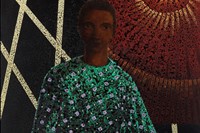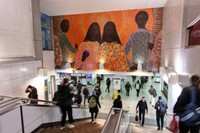As Jem Perucchini’s mural goes on display at Brixton underground station, Alayo Akinkugbe speaks with the artist who combines influences from West and East Africa and the Italian Renaissance
Art historian, curator and writer Alayo Akinkugbe is behind the popular Instagram page A Black History of Art, which highlights overlooked Black artists, sitters, curators and thinkers, past and present. In a column for AnOthermag.com titled Black Gazes, Akinkugbe examines a spectrum of Black perspectives from across artistic disciplines and throughout art history, asking: how do Black artists see and respond to the world around them?
Across the road from Brixton Underground station, the silhouettes of two Black women backlit by a warm, orange glow catch my eye. Their heads peer over the staircase that leads in and out of the station, quietly looming over commuters. This arresting and unlikely intervention in the tube station is the work of Ethiopian-Italian artist, Jem Perucchini, who was commissioned by Art on the Underground to create Rebirth of a Nation, an oil painting which has been enlarged and reproduced on the station’s wall as a monumental mural.
On the rainy autumn morning when I saw Perucchini’s commission, it was an unexpected – and very welcome – beacon of light. Making an uplifting work “was important” says Perucchini, given that it’s a space through which thousands pass every day; he hopes that Rebirth of a Nation will “instill a sense of pride in the Brixton community.”
Perucchini is no stranger to London; he had a solo exhibition with Corvi-Mora last year, and has shown at Frieze London with the gallery for the past two years. However, as an artist who has lived in Milan for most of his life, he found it rewarding to discover Brixton’s “rich and vibrant community”, and describes this area of London as “a melting pot of cultures and stories.” Brixton has been known for its large Afro-Caribbean population from the 1940s onwards, with many families of the Windrush generation settling there, but in recent years the population has been dwindling due to the rise of gentrification in the area.
Perucchini’s work, Rebirth of a Nation, gets its title from the 1915 film, The Birth of a Nation, by American director David Wark Griffith. “This film had a clearly racist and misleading agenda regarding the founding of the United States, and I was struck by this title for its glorification of these purposes,” says Perucchini. The film portrays Black people using white actors in blackface, and presents the KKK as heroic. Perucchini subverts the title to present a much more dignified portrayal of Black people than in the film, and the work acts as an ode to “the lesser-known past of a community and the hope for a more equitable and inclusive future.”

The mesmerising geometrical patterns on the clothing of the figures combine influences from West and East Africa, and the Italian Renaissance; an amalgamation which is unique to Perucchini’s style. He refers to wax-print fabrics, worn prolifically in West Africa, “as well as traditional Ethiopian clothing and the geometric decorations in the attire of [figures in] Renaissance paintings.”
Influenced by Renaissance frescoes and altarpieces, Perucchini’s work is an unlikely apparition in the public space of the London underground, and it is this which makes it so incredibly striking. The golden tones, purple orb and concentric, halo-like circles in the background, give the overall effect of something saintly or sacred, a work of art which might be expected within a church or a museum, but is firmly outside of the visual language of a tube station. Rebirth of a Nation acts as a secular altarpiece within an everyday setting.
